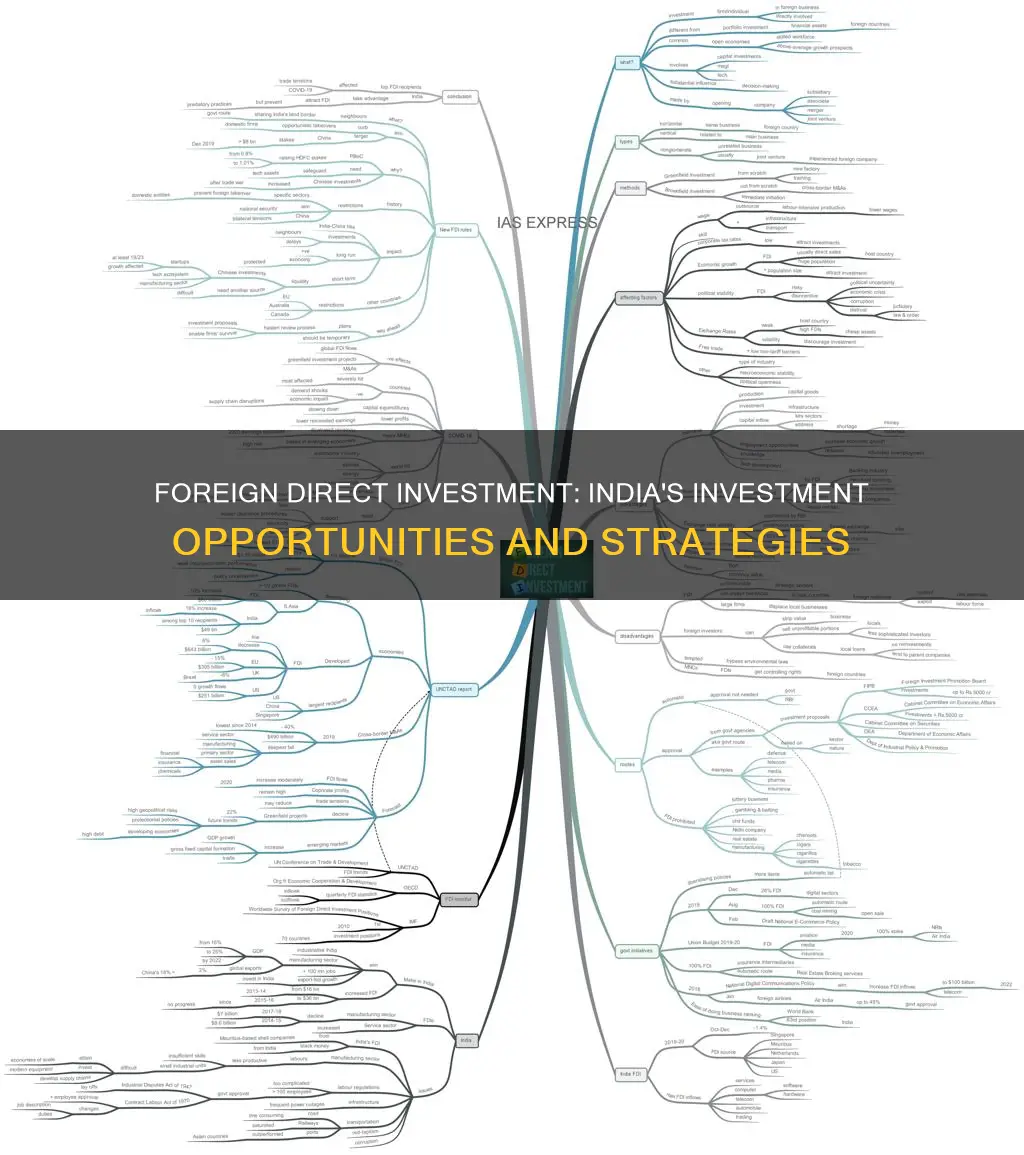
Foreign Direct Investment (FDI) is a key driver of India's economic growth, with the country attracting USD 70.97 billion in FDI inflows during the 2022-23 financial year. FDI is a significant source of non-debt finance for India's economic development, and the country has implemented a range of policies and initiatives to enhance it. The Make in India campaign, for instance, focuses on simplifying procedures and promoting a favourable investment climate across sectors.
FDI in India can be made through two routes: the Automatic Route and the Government Route. The former does not require approval from the Reserve Bank of India or the Government of India, while the latter requires prior approval from the Government of India, with proposals considered by the respective Administrative Ministry or Department.
India offers a range of sectors for FDI, including agriculture, manufacturing, broadcasting, air transport services, and more. The service sector, computer software and hardware, and trading are among the major receivers of FDI in India.
With its dynamic business environment, improving global competitiveness, and burgeoning economic influence, India offers a host of investment opportunities for international corporations.
| Characteristics | Values |
|---|---|
| FDI Inflow 2022-23 | USD 70.97 billion |
| FDI Inflow 2021-22 | USD 84.84 billion |
| FDI Inflow April 2000-September 2024 | USD 708.65 billion |
| FDI Inflow April 2000-March 2023 | USD 919 billion |
| FDI Inflow April 2014-March 2023 | USD 595.25 billion |
| Top 5 Sectors for FDI Equity Inflow 2022-23 | Services Sector, Computer Software & Hardware, Trading, Telecommunications, Automobile Industry |
| Top 5 Countries for FDI Equity Inflow 2022-23 | Mauritius, Singapore, USA, Netherland, Japan |
| Top 5 States for FDI Equity Inflow 2022-23 | Maharashtra, Karnataka, Gujarat, Delhi, Tamil Nadu |
| FDI Route | Automatic Route, Government Route |
| FDI Permitted Under Sectors as per FDI Policy 2020 | Agriculture, Air-Transport Services, Airports, Asset Reconstruction Companies, Auto-components, Automobiles, Biotechnology, Broadcast Content Services, Capital Goods, etc. |
| FDI Prohibited Sectors | Lottery Business, Gambling and Betting, Chit Funds, Nidhi Company, Trading in Transferable Development Rights, Real Estate Business or Construction of Farm Houses, etc. |
What You'll Learn

Foreign Direct Investment (FDI)
There are two routes for overseas investors to invest in India under FDI: the Automatic Route and the Government Route. The Automatic Route does not require any approval from the Government of India, while the Government Route requires prior approval from the Government of India before investment.
The Indian government has implemented a range of policies and initiatives to enhance FDI in the country, including the "Make in India" campaign, which focuses on simplifying procedures and promoting a favourable investment climate across sectors. Liberalization of FDI policies, particularly in retail, defence, insurance, and single-brand retail trading, has been a key strategy. The Goods and Services Tax (GST) implementation has improved transparency, while Special Economic Zones (SEZs) provide dedicated spaces with tax incentives.
Step 1: Choosing the Sector
When making an FDI in India, it is important to consider the sector-specific guidelines and restrictions. The Indian government has outlined specific sectors that are permitted for FDI under the Automatic Route and the Government Route. These sectors include agriculture, manufacturing, pharmaceuticals, broadcasting, banking, and more. It is essential to review the latest FDI policy and seek expert advice to ensure compliance with the applicable regulations.
Step 2: Understanding the Entry Route
As mentioned earlier, FDI in India can be made through the Automatic Route or the Government Route. The Automatic Route is generally preferred as it does not require prior government approval. However, for sectors that require government approval, investors need to follow the necessary procedures and obtain the required approvals before making their investment.
Step 3: Registration and Compliance
For the Automatic Route, foreign investors can proceed with their investment plans without any additional registration or compliance requirements from the Indian government. However, for the Government Route, investors need to register and apply for approval through the Foreign Investment Facilitation Portal (FIFP). This portal is administered by the Department of Industrial Policy and Promotion and the Ministry of Commerce and Industry. The application process may involve submitting relevant documents, providing information about the investment, and seeking approval from the respective administrative ministry or department.
Step 4: Investment Methods
Once the sector and entry route are determined, investors can choose from various methods to make their FDI in India. These methods include subscription to the Memorandum of Association (MoA), merger or amalgamation, preferential allotment or private placement, purchase of shares from Indian residents or companies, conversion of convertible notes, and swap of capital instruments. It is important to understand the specific requirements and procedures for each method.
Step 5: Reporting and Compliance
After receiving the foreign investment, Indian companies must comply with reporting requirements. The Foreign Investment Reporting and Management System (FIRMS) Portal, introduced by the Reserve Bank of India (RBI), integrates the reporting structures for various types of foreign investments. Indian companies need to update the Entity Master Form, register the Business User, and file the required forms on the FIRMS Portal, such as the Single Master Form (SMF) and other sector-specific forms.
Step 6: Regulatory Support
To facilitate FDI in India, organisations like Invest India provide support and assistance to investors. Invest India acts as a concierge, gateway, and facilitator for investors, offering services such as strategic location assessment, single-window clearance support, continuous relationship management, and advisory services. Engaging with such organisations can help investors navigate the regulatory landscape and streamline their investment process.
Unlocking Home Equity: Investment Loan Options
You may want to see also

Foreign Portfolio Investors (FPIs)
Understanding Foreign Portfolio Investors (FPIs)
Foreign Portfolio Investment (FPI) involves investors acquiring financial assets such as stocks, bonds, and other securities in a foreign country without directly owning or controlling the underlying assets or businesses. FPI is a passive form of investment, where investors do not actively manage or control the investments. It is a common way for retail investors to participate in overseas markets and diversify their portfolios.
Eligibility Criteria for FPIs in India
To register as an FPI in India, an investor must satisfy certain eligibility criteria as per the Securities and Exchange Board of India (SEBI) regulations. Here are the key requirements:
- The investor should not be a resident of India.
- The investor should be a resident of a country that has signed a bilateral Memorandum of Understanding (MoU) with SEBI or has a securities market regulator that is a signatory to the International Organisation of Securities Commission's Multilateral MoU.
- The investor should not be a resident of a country identified by the Financial Action Task Force (FATF) as having strategic Anti-Money Laundering or Combating the Financing of Terrorism deficiencies.
- If the applicant is a bank, it should be a resident of a country whose central bank is a member of the Bank for International Settlements (BIS).
- The investor should not be a Non-Resident Indian (NRI).
- The investor should be legally permitted to invest in securities outside their own country.
- The investor should have sufficient experience, a good track record, and a reputation for fairness and integrity.
Categories of FPIs in India
SEBI categorizes FPIs into two main groups:
- Category I FPIs: These include entities with higher regulatory oversight and lower risk profiles, such as government and government-related entities, pension funds, sovereign wealth funds, and appropriately regulated entities.
- Category II FPIs: These include entities that do not meet the criteria for Category I, such as corporate bodies, family offices, limited partnerships, and individuals.
Registration Process for FPIs in India
To register as an FPI in India, foreign entities need to follow these steps:
- Submit a Common Application Form (CAF) with their local sub-custodian in India, along with supporting documents and know-your-customer (KYC) details.
- Upon approval, obtain FPI registration and a Permanent Account Number (PAN), which is the Indian tax ID.
- Establish a security and depository account in India.
- Identify and report ultimate beneficial owners (UBOs) to the local custodian.
- Ensure that investments by NRIs, Overseas Citizens of India (OCIs), and resident Indians in an FPI do not exceed an aggregate limit of 50%, with each NRI, OCI, and resident Indian allowed to invest up to 25%.
Permissible Investments and Limits for FPIs in India
FPIs in India can invest in a range of securities, including:
- Listed or to-be-listed equity instruments.
- Debt instruments such as corporate bonds and government securities.
- Derivatives.
- Units of mutual funds and exchange-traded funds (ETFs).
- Real Estate Investment Trusts (REITs) and Infrastructure Investment Trusts (InvITs).
FPIs need to comply with investment limits set by SEBI and the Reserve Bank of India (RBI). For example, any FPI and its investor group can invest up to 10% of the paid-up value in the equity instruments of a listed Indian company.
Benefits and Risks of FPI in India
FPI in India offers several advantages, including the ability to diversify portfolios, access high-growth opportunities, and benefit from India's improving business environment and economic stability. However, FPI also comes with risks, including currency fluctuations, political instability, regulatory changes, and economic volatility in the foreign market.
Investments: Earning $100 Monthly with a Smart Strategy
You may want to see also

Foreign Venture Capital Investment (FVCI)
To qualify as a foreign venture capital investor in India, an entity must satisfy three essential criteria:
- The entity must be established or incorporated outside India.
- It must be registered with SEBI as an FVCI.
- The investment proposal should comply with the FVCI Regulations.
The eligibility criteria for an FVCI certificate from SEBI include assessing the applicant's track record, professional competence, experience, and reputation for fairness and integrity. The applicant must also be authorised to invest in VCFs or carry out FVCI activities and obtain approval from the Reserve Bank of India (RBI) for making investments in India.
Once certified as an FVCI, investors can make two types of investments:
- Indian Venture Capital Undertaking (VCU): VCUs are typically new companies trying to establish themselves in the market and require financial support and expertise. They are incorporated in India, with unlisted shares, and are not engaged in any activities on SEBI's 'negative list'.
- Venture Capital Fund (VCF): VCFs are funds established by companies or trusts, registered under SEBI regulations, with a dedicated pool of capital to invest in VCUs.
SEBI has outlined specific guidelines for FVCI investments, including a minimum investment of 66.67% of investible funds in equity-linked instruments or unlisted equity shares of a VCU. Up to 33.33% of investible funds can be invested in IPO subscriptions, debt instruments, preferential allotment of equity shares, and investments in sick or financially weak companies. Additionally, FVCIs are permitted to invest 100% of their funds in domestic VCFs registered with SEBI, provided they disclose their investment strategy and fund lifecycle.
FVCI investors have certain obligations and responsibilities, including maintaining records, documents, and books of accounts for a specified period. They must also appoint a designated bank branch approved by the RBI for opening foreign currency accounts or special non-resident rupee accounts. Taxation on income from FVCI investments is governed by the Income Tax Act, 1961, and Double Taxation Avoidance Agreements (DTAAs) between India and other countries.
In conclusion, FVCI is an important tool for promoting Indian enterprises and innovations. India's regulatory framework offers a range of relaxations and incentives, making it an attractive destination for foreign venture capital investments.
Invest Wisely: Millions Made, a Forbes-Worthy Guide
You may want to see also

External Commercial Borrowings (ECBs)
ECBs include commercial bank loans, buyers' credit, suppliers' credit, and securitised instruments such as floating-rate notes and fixed-rate bonds. They are governed by the Foreign Exchange Management Act, 1999, and monitored by the Department of Economic Affairs, Ministry of Finance, and the Reserve Bank of India.
There are two methods to raise funds through ECBs: the automatic route and the approval route. Under the automatic route, the case is examined and approved by AD Category-I Banks, whereas under the approval route, borrowers send their requests to the Reserve Bank of India through their AD banks for examination.
ECBs have a specific period called the Minimum Average Maturity Period (MAMP) within which they can be raised. The funds borrowed through ECBs cannot be used for investment in the stock market or speculation in real estate.
The benefits of ECBs include lower interest rates compared to domestic funds, the ability to borrow large volumes, and the availability of funds for a relatively long term. Additionally, ECBs enable corporates to access foreign currencies to meet import requirements.
However, there are also disadvantages to ECBs. Companies may become lax in their financial management as they have easy access to lower-rate funds, leading to higher debt and adverse effects on financial ratios. The company also exposes itself to exchange rate risks as the principal and interest are to be paid in foreign currency.
Overall, ECBs are a commonly used tool for Indian entities to access foreign funds, offering both advantages and challenges.
Structuring Your Investment Portfolio: The ETF Advantage
You may want to see also

Depository Receipts (DRs)
DRs are typically classified as either sponsored or unsponsored. Sponsored DRs involve a formal agreement between the foreign depository and the Indian issuer, with the issuer creating or issuing new DRs. This can be further classified as capital raising or non-capital raising. In capital raising, the issuer deposits new securities with a domestic custodian, and the foreign depository creates DRs that are sold to foreign investors. In non-capital raising, the issuer gets holders of its existing securities to deposit them with a domestic custodian so that DRs can be issued by the foreign depository. Unsponsored DRs, on the other hand, do not have a formal agreement between the foreign depository and the Indian issuer. Instead, any person other than the Indian issuer may deposit the securities with a domestic custodian, and the foreign depository then issues DRs abroad.
DRs can also be classified as listed or unlisted, depending on whether they are traded on organised exchanges or in the over-the-counter (OTC) market. The most common example of a listed DR is an ADR traded on the New York Stock Exchange (NYSE). Unlisted DRs, on the other hand, are traded OTC between parties and are not listed on any formal exchange.
The regulatory regime for DRs in India has evolved over time. Initially, the issue of DRs was regulated by the "The Issue of Foreign Currency Convertible Bonds and Ordinary Share (through Depository Receipt Mechanism) Scheme 1993", formulated when India's capital markets were largely closed to foreign investment. However, in recent years, the equity market has become more sophisticated and capital controls have been eased. As a result, the "Depository Receipts Scheme, 2014" was implemented to liberalise the ADR/GDR regime and allow the issuance of DRs on all permissible securities.
Overall, DRs provide foreign investors with an opportunity to invest in Indian securities without the need to directly purchase stock on Indian exchanges, reducing transaction costs. They are also a way for Indian companies to raise capital from foreign investors and attract international attention. However, it's important to note that DRs are generally only suitable for high-net-worth individuals as they require large amounts of capital to trade.
Revisiting Investment Portfolio: Strategies for Staying Ahead
You may want to see also
Frequently asked questions
FDI refers to an investment made by a company or individual in one country into a business in another country. In the context of India, FDI refers to an investment by a foreign entity in an unlisted Indian company or a minimum of 10% in a listed Indian company.
Foreign investors are encouraged to engage in FDI due to market diversification, access to local expertise, lower labour costs, and tax incentives, among other advantages.
Foreign investors can invest in India under two routes: the Automatic Route and the Government Route. The Automatic Route does not require prior approval from the Reserve Bank or the Government of India, while the Government Route necessitates prior approval from the Government.
Sectors permitting 100% FDI under the Automatic Route include agriculture, plantation, mining, manufacturing, broadcasting services, construction development, trading, pharmaceuticals, and petroleum & natural gas exploration.
FDI is prohibited in lottery businesses, gambling and betting activities, real estate, manufacturing of tobacco products, and sectors closed to private sector investment, such as atomic energy and railway operations.







